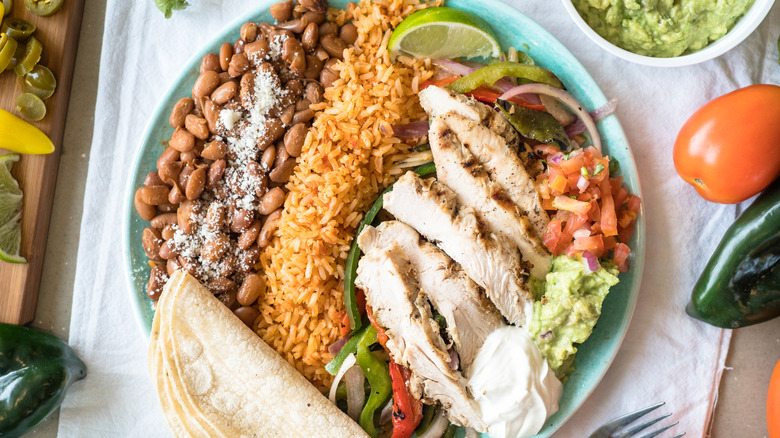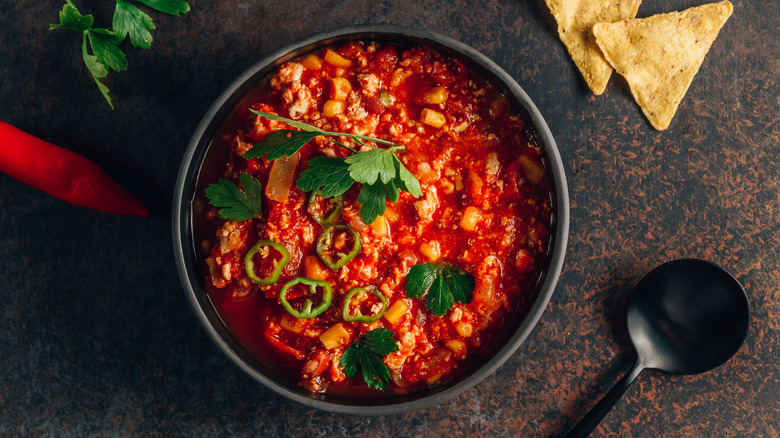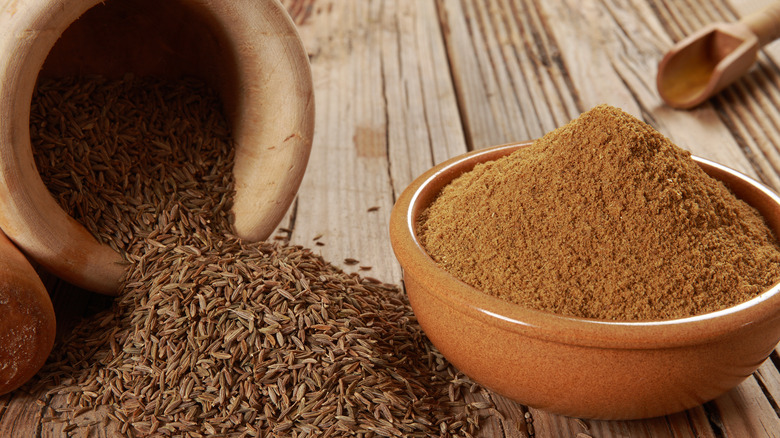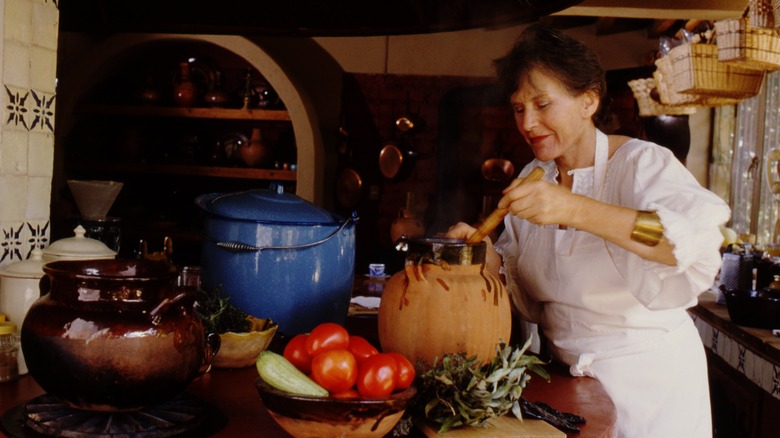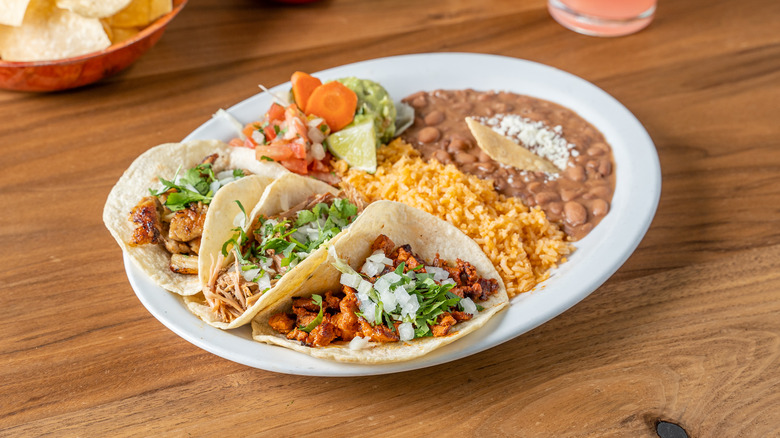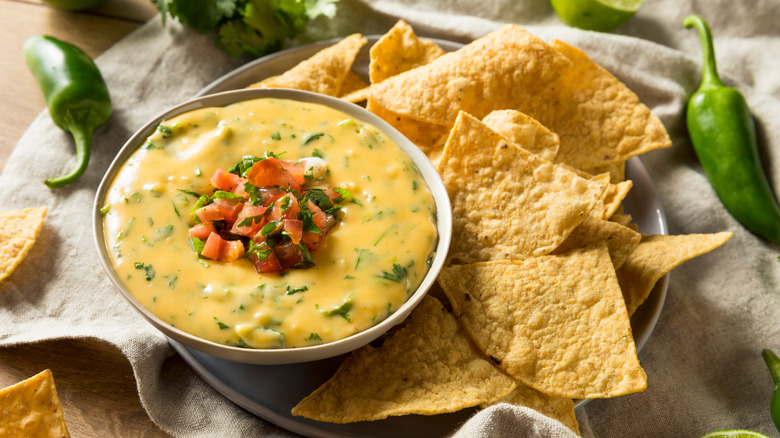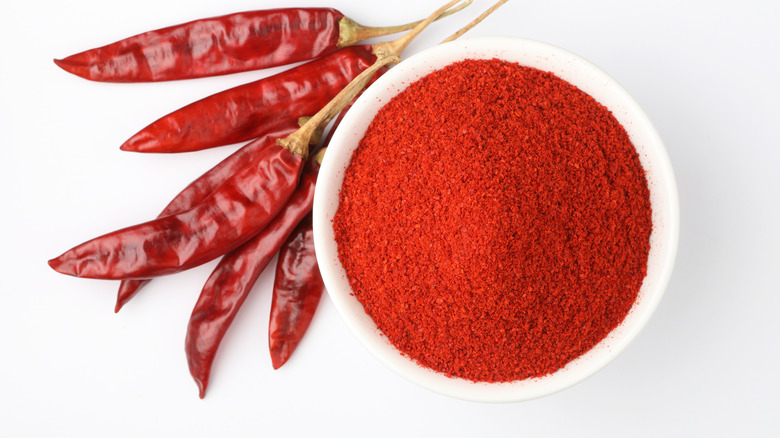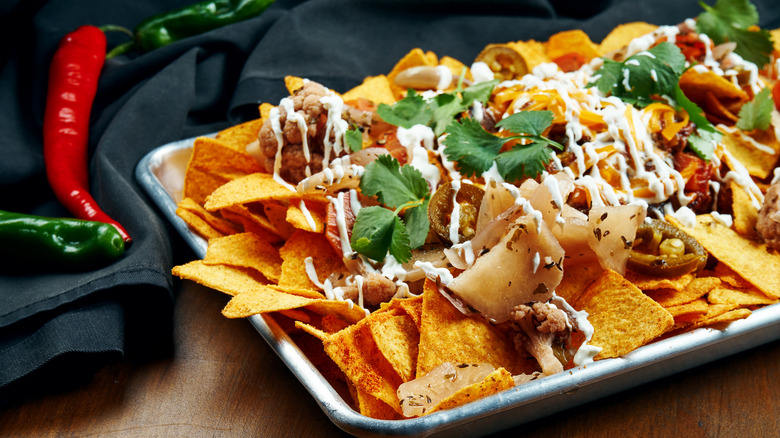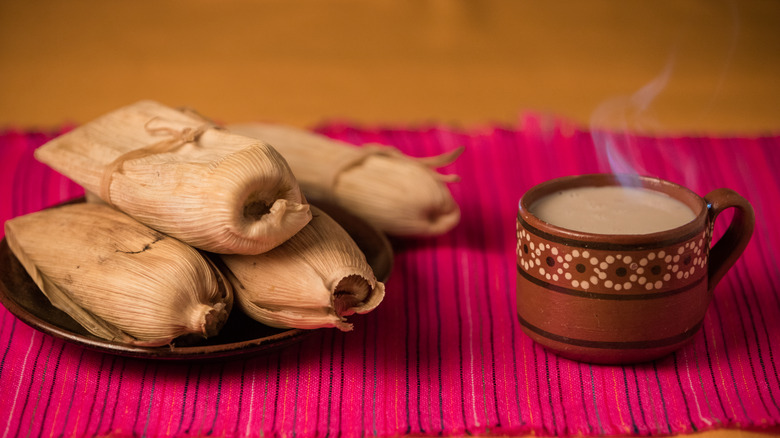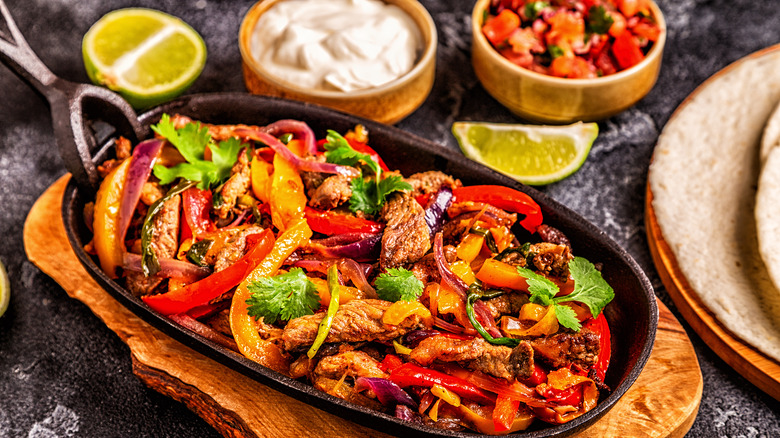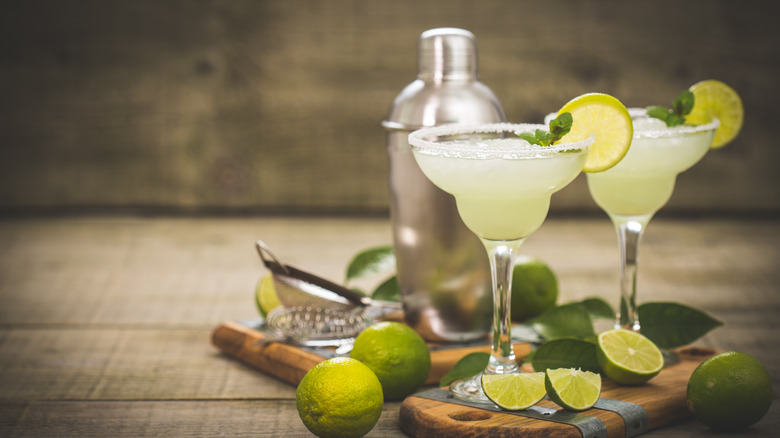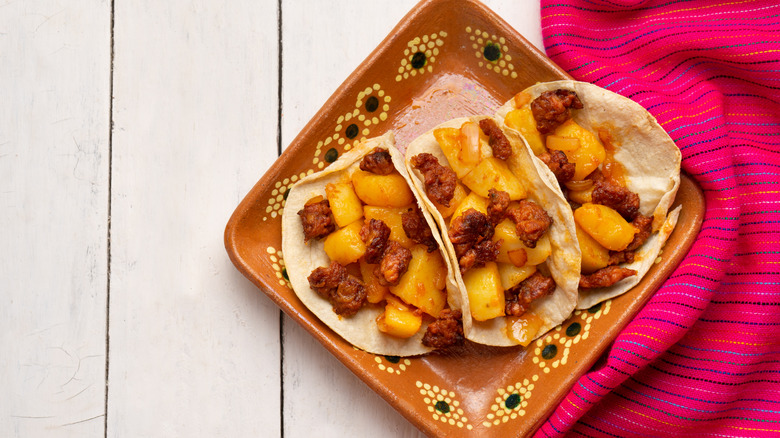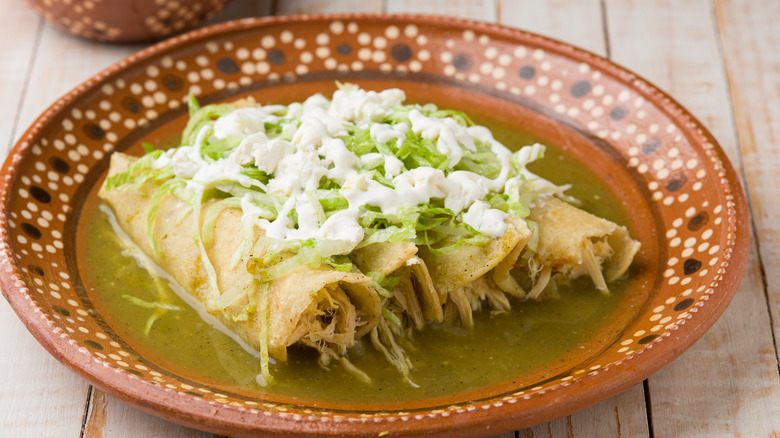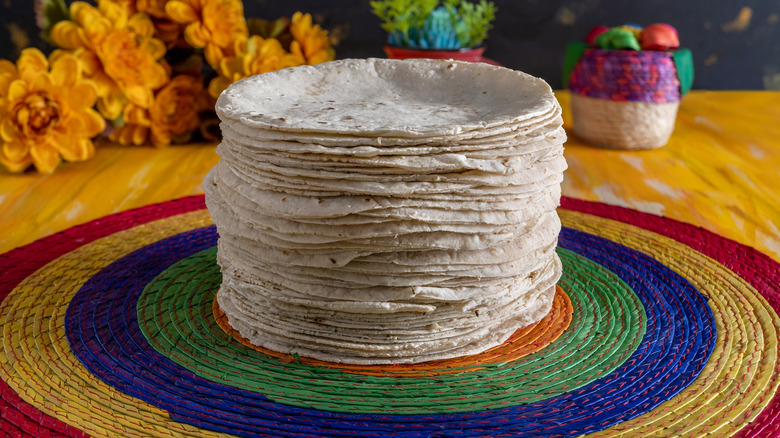The Truth About Tex-Mex
Tex-Mex is now one of America's favorite foods, with restaurants in every state serving up dependable classics like margaritas, enchiladas, tacos, and queso. Since it's so ubiquitous now, it's shocking that the cuisine didn't start spreading across America until well into the 20th century. While many Tex-Mex dishes existed in some form hundreds or even thousands of years ago, most of the modern versions of these foods were invented less than a century ago. The history of Tex-Mex, and of all styles of Mexican food, involves centuries of cultural dialogue between European conquerors and indigenous people. Tex-Mex is a complex blend of Native American, Spanish, Anglo-American, and Mexican food. The innovations of a few Texas entrepreneurs took what had been a local, regional cuisine and turned it into a global sensation. That's not to say Tex-Mex had an easy road. The cuisine's backstory includes more than a little violence and prejudice. This is the truth about Tex-Mex.
Chili was born out of conflict
Chile con carne (shortened to chili), is generally believed to be the first Mexican dish widely enjoyed by people in Texas from all cultural backgrounds. Because of this, chili can be thought of as the origin of Tex-Mex food. As reported by Texas Monthly, the most widely accepted story about chili's rise to prominence stars the Chili Queens, women who sold chili and tamales on the streets and plazas of San Antonio starting in the 1880s. Although the Chili Queens are definitely responsible for chili becoming ubiquitous among San Antonio's population, they did not invent the dish. Before chili stalls popped up all over the city, curious travelers could often go to houses in the predominantly Mexican Laredito neighborhood to sample some home cooking. These informal eating establishments served stewed meats in chile sauce that sound quite similar to modern chili.
One story suggests that this tradition started in the aftermath of an infamous massacre in 1813. A force of Americans, Spanish rebels, and mercenaries marched into San Antonio as part of an effort to remove Texas from royal Spanish rule. After taking the city, the rebels killed dozens of captive royalists after promising them they could leave alive. Disgusted residents of San Antonio refused to give sustenance to the rebels. An unlikely husband-and-wife team of a rebel man and a royalist woman decided to start a restaurant for the rebels that served chili, and the rest is history.
The heavy use of cumin is influenced by Moroccan cuisine
Cumin is one of the signature spices in Tex-Mex's flavor profile, adding savory smokiness to chili, salsas, and fajitas. However, according to Thrillist, you won't find cumin in much Mexican food outside of America and far northern Mexico. The book "Cumin, Camels, and Caravans: a Spice Odyssey" claims that cumin probably originated in western Asia, but it spread so quickly around the ancient world that it's hard to tell for sure who first started using it in food. As an Old World crop, cumin didn't arrive in the Americas until Europeans arrived. Food historian Robb Walsh writes in his "Chili Cookbook" that the earliest references to cumin in Mexico come from the early 1700s when it was used by Spanish cooks in missions.
Walsh argues that these Spanish cooks probably used very small amounts of cumin, and that the spice didn't become an integral part of Texas' regional cuisine until settlers from the Canary Islands arrived. The Spanish government encouraged the Canarians to settle in what is now San Antonio because of the area's low population. The Canary Islands, though controlled by Spain, are located off the coast of Africa, and their cuisine is similar to Moroccan food in its heavy use of cumin and garlic. Canarian preferences for cumin-scented meat stews combines with New World crops like chile peppers to create the blueprint for chile con carne.
A British chef popularized the name
The first use of "Tex-Mex" in print didn't refer to food, but rather to a railway line. Mitú notes that the name was a shorthand for the Texan-Mexican railway. The Tex-Mex rail route supplied Mexican consumers with sheep raised in Texas. The first written evidence of someone using Tex-Mex to describe Texas-style Mexican food came about after appearing in magazine articles in the 1940s. The person responsible for popularizing the idea of Tex-Mex food is British food writer Diana Kennedy. She used the phrase in 1972 to distinguish Mexico's indigenous regional cuisine from the fare served at restaurants in America's southwest. She disdained Tex-Mex, considering it to be a watered-down version of "real" Mexican food. Kennedy's work in documenting the local foodways of Mexico was recognized by the Mexican government with the Order of the Aztec Eagle, the most prestigious award a non-Mexican can receive.
Mexican restaurateurs in Texas initially viewed Tex-Mex as an insulting term, but the name took hold over time. These days, we have a more nuanced view of the history of Tex-Mex, and understand that it's an independent cooking tradition and not merely Americanized Mexican food.
It's an authentic regional cuisine
Although there is some validity to the common assertion that Tex-Mex is Mexican food adapted for American palates, the truth is much more complicated. Culture Trip asserts that Tex-Mex cuisine came about from a long process of cultural exchange between Spanish colonists and Mexican culinary traditions. The History Channel also notes that many food preparations in the region also have their roots in Native American recipes that existed for hundreds of years before Europeans set foot in the New World. When Mexico won its independence from Spain in 1821, Texas was a Mexican province that already had its own distinct set of culinary practices. Texas didn't separate from Mexico until 1836, and only became part of America nine years after that. To call Tex-Mex "Americanized" Mexican food is to ignore the fact that Texas was part of Mexico for the entirety of its early history.
Modern Tex-Mex food is based on the home cooking of Tejanos, people of Mexican descent living in Texas. They adapted foreign ingredients like wheat flour, cheese, and beef into their traditional recipes to create a new style of cooking that spread all over the American Southwest and northern Mexico. Tex-Mex is properly understood as a specialized regional variation of Mexican food that is just as legitimate as the celebrated cuisine in Mexican states like Oaxaca and Puebla.
A guy from Chicago introduced Tex-Mex to the masses
Many of the conventions of restaurant Tex-Mex cuisine were invented by a Chicago transplant to San Antonio named Otis Farnsworth, who opened Farnsworth's Original Mexican Restaurant in the Texas city at the turn of the century. As Chef's Pencil reports, Farnsworth began serving rice and beans with tamales and enchiladas, inventing the combo plate that has become a staple in every Tex-Mex restaurant around the country.
But Farnsworth's primary contribution to Tex-Mex's legacy was his marketing sense rather than his culinary chops. The Houston Press notes that Farnsworth's restaurant was the first Mexican eatery that explicitly marketed itself to Anglos rather than people of Mexican descent. Farnsworth cultivated an upscale ambiance at his restaurant, building a grand dining room and requiring customers to dress in their finest clothes. The experience at the Original was quite different from the other options for Mexican food in San Antonio at the time, which were mostly street carts or small homestyle restaurants in working-class neighborhoods.
The success of Farnsworth's formula inspired both Mexican-American and Anglo entrepreneurs to open upscale Tex-Mex restaurants in cities across Texas, spreading classic dishes like enchiladas, chile con queso, and tamales to people of all backgrounds in every region of the state.
Texas and Arkansas both claim to have invented queso
Eater writes that chile con queso is a dish with a long history and multiple inventors. Mexico has a wide variety of traditional melted cheese dishes, but they aren't anything like the mixture of processed American cheese and chiles that we know today. Some sources point to Otis Farnsworth as the inventor of modern queso, as chile con queso appears on menus from his Original Mexican Restaurant in the early 20th century. However, the exact composition of Farnsworth's queso is lost to time, so we can't be sure whether the dish served at the Original in San Antonio was more like Mexican queso fundido or the orange gloop most Tex-Mex restaurants serve today. The first recipes for processed cheese-based queso come from community cookbooks in San Antonio in the 1920s.
Although the historical record makes it pretty clear that queso began somewhere in the vicinity of San Antonio, the state of Arkansas decided to try to claim credit for the dish in 2016 (via The Wall Street Journal). Partisans of Arkansas' cheese dip say that it was created at a Mexican restaurant in Little Rock in the 1930s. While that may be true, that's still a decade after housewives in San Antonio began publishing queso recipes, so the Arkansas claim seems more like a PR stunt than a legitimate bid for recognition.
Chili powder was invented by a German immigrant
Chili powder is the basic seasoning for a huge variety of Tex-Mex dishes, from chili (obviously) to taco meat and enchilada sauce. Despite its ubiquity in Tex-Mex food today, the blend of ground chilis combined with cumin, oregano, garlic, and other spices isn't a traditional part of Mexican cooking. Historically, Mexican cooks used whole chili peppers to prepare dishes rather than using the dried, ground variety (via Spiceography). Home cooks would dry their own fresh chiles and grind them manually, an inconvenient and time-consuming process (via Saveur). In 1896, a German immigrant in the Texas Hill Country town of New Braunfels adapted the Hungarian method for grinding paprika from dried peppers to the local Mexican chiles available in the region. He blended his new chile powder with other popular Mexican spices to create an all-purpose Tex-Mex seasoning blend that he dubbed Gebhart's Eagle Brand Chili Powder. The convenience and ease of Gebhart's new product allowed Tex-Mex flavors to spread beyond their birthplace in the home kitchens of Tejano families. With chili powder, even cooks in the northern U.S. who had never eaten Mexican food before could easily make chili at home.
Although Gebhart was the one who introduced America to chili powder, it may have been invented independently by a Fort Worth businessman a couple of decades before Gebhart started putting his name on bottles. According to D Magazine, a spice merchant named Dewitt Clinton Pendery began selling pulverized chili peppers at his store in 1870, beating Gebhart by 26 years.
A Texas businessman made nachos a global sensation
Nachos are a great example of the cultural interplay that birthed so many classic Tex-Mex dishes. They were invented by Ignacio "Nacho" Anaya in Piedras Negras, a city on the Mexican side of the Texas border (via The New York Times). He was the maitre d' at a restaurant called the Victory Club in 1940 when a group of American military wives from across the border in Eagle's Nest, Texas came to the restaurant looking for a drink and some light bites. With no cooks in the kitchen that afternoon, Nacho Anaya improvised a simple appetizer of fried tortilla wedges, Colby cheese, and jalapenos baked together on a sheet pan. The ladies loved Nacho's invention, and it quickly appeared on the Victory Club's menu.
Nachos grew in popularity over the next few decades, but they didn't take over the world until Texan entrepreneur Frank Liberto invented shelf-stable nacho cheese sauce and the pump that squeezed the cheese onto chips. This new type of nachos debuted in the Texas Rangers baseball stadium in 1976. They were quickly adopted by the NFL as well, showing up at Dallas Cowboys games one year later. From there, the trashy-tasty combo of processed cheese sauce and tortilla chips spread across the country.
In Texas, tamales are a traditional Christmas treat
What does Christmas food mean to you? Almost every culture that celebrates the holiday includes some kind of special meal as part of the festivities. If you're Italian-American, Christmas Eve might have meant a Feast of the Seven Fishes dinner with heaping plates of clam spaghetti and mussels marinara. The classic English-American Christmas dinner revolves around a roasted bird and slices of fruitcake. For many Mexicans and Mexican-Americans living in Texas, Christmas Eve calls for a big tamale-making party.
San Antonio-based folklorist Rhett Rushing told NPR that tamales and Christmas have gone together for hundreds of years. In many families, everyone gathers together on Christmas Eve for a tamalada, or tamale-cooking session. Tamales are a natural fit for festive occasions because they're relatively inexpensive and easy to cook in bulk for large numbers of people. Families who don't feel like making their own tamales make sure to order them in time for Christmas Eve, often reserving them a month in advance.
Fajitas were a way to use undesirable cuts of beef
Fajitas were born out of resourcefulness and necessity. Mexican cowboys working on cattle ranches along the Rio Grande in West Texas often received cuts of beef as part of their compensation. Of course, the more expensive bits of the cow were reserved for paying customers, so the ranch hands had to figure out recipes to use tougher cuts like skirt steak (via What's Cooking America). In fact, skirt steak looks kind of like a belt, and the word fajitas means "little belts" in Spanish.
Although the identity of the first fajita cook is lost to time, several people claim that they came up with the dish. Sonny Falcon alleges that he came up with the idea of serving little slices of skirt steak wrapped in flour tortillas sometime in the 1960s. He toured county fairs and other events selling fajitas. He trademarked his nickname "The Fajita King" and unsuccessfully tried to copyright the word fajitas. A woman named Ninfa Rodriguez Laurenzo also claims to have invented fajitas at her restaurant in 1948. However, both of these stories come from after cowboys in West Texas had been grilling skirt steak for years.
Frozen margaritas were invented in Texas
Like many other Tex-Mex classics, the it's hard to pin down the real inventor of the margarita. A socialite from Dallas named Margarita Sames said she invented the drink for guests at her second home in Acapulco (via Smithsonian). Sames definitely raised the profile of the margarita in the U.S., because hotelier Tommy Hilton enjoyed Margarita's drink so much that he began serving it at his hotels. However, Sames claimed the party in question happened in 1948, three years after the cocktail appeared in an ad for Jose Cuervo. Carlos "Danny" Herrera's claim to have invented the drink in 1938 for actress Marjorie King is more plausible, but all of the margarita's origin stories are hard to corroborate.
The margarita had already been around for decades by the time the frozen margarita machine hit the scene. According to Wine Enthusiast, bartenders started blending up slushie margaritas in the 1950s, but the labor-saving rotating machines you see in every Tex-Mex restaurant were invented in Dallas in 1971 by restaurant owner Mariano Martinez.
Breakfast tacos inspire heated fights between Texas cities
Austin is seen by many as the home of the breakfast taco, but it's a relative latecomer to the breakfast taco party (via Vice). Although Austin's breakfast tacos get more national attention due to the city's high profile media presence, the dish actually originated in the Rio Grande Valley in south Texas. There, home cooks served tacos at all times of day, including breakfast. No one thought to call them "breakfast tacos" because they were simply normal tacos that were eaten in the morning. Taco culture spread from the Rio Grande to San Antonio and the Hill Country outside of Austin. The breakfast taco began supplanting the breakfast burrito on restaurant menus in Texas in the 70s and 80s.
The competition over what city in Texas serves the best breakfast tacos is fierce. A petition called for the city of Austin to surrender to San Antonio and admit that city's taco superiority. Austin mayor Steve Adler responded with some smart remarks of his own, and the Great Breakfast Taco War commenced. Eventually, the mayors of the two cities held an official ceremony to bury the hatchet.
Enchiladas were viewed with suspicion by early European settlers
D Magazine reports that enchiladas are now the most popular menu item at Tex-Mex restaurants in Dallas, but they weren't always viewed positively by non-Mexicans. Enchiladas are one of the oldest dishes in Mexican cuisine, stretching all the way back to Aztec times (via History Today). Back then, Aztec royals ate elaborate enchiladas made of corn tortillas stuffed with all kinds of fillings including eggs, meat, and fish. At the same time, normal Aztec citizens ate a simpler version of the dish made of tortillas dipped in a chile pepper paste. When the Spanish colonists arrived, they began making their own version of the dish that used European ingredients like cheese and pork. In the 19th century, enchiladas became a part of Mexico's new national identity, a hybrid between Aztec and Spanish traditions.
But many reviews of the dish from Anglos in the 19th century are quite negative. One disdainful critic described them as "greasy tortilla sandwich[es], containing chilies and a number of other uninviting looking compounds and other nasty messes." English-speaking people in the Southwest began to enjoy enchiladas in the 20th century as they grew more familiar with Mexican flavors.
Flour tortillas might have been created by Jewish immigrants in Mexico
Corn tortillas are ancient, and have been eaten in the region we now call Mexico for thousands of years. Flour tortillas have a much more recent history. The Houston Chronicle notes that settlers invented flour tortillas after the Spanish conquest of Mexico. Europeans initially disdained corn, viewing it as animal feed rather than food for humans. They used the wheat flour they brought from Europe to make tortillas instead of the traditional masa.
It's also possible that the flour tortilla has Jewish roots. Some of the colonists in Mexico were conversos, Spanish Jews who were forced to convert to Catholicism by the Spanish government. Although they couldn't practice Judaism openly, they retained many of their traditional customs long after they became Christian. Spanish Jewish cuisine included flatbreads that are somewhat similar to the modern flour tortilla. Some sects of Judaism also couldn't eat corn because it wasn't considered kosher. Thus, Spanish conversos in Mexico may have been the first to substitute wheat for corn when making tortillas.
